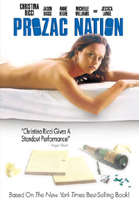 BUY IT AT AMAZON: CLICK HERE!
BUY IT AT AMAZON: CLICK HERE!
STUDIO: Miramax
MSRP: $29.99 RATED: R
RUNNING TIME: 95 Minutes
SPECIAL FEATURES: "Anatomy of a Scene" featurette
In a
sophomore literature class at college, I had my first experience with Charlotte
Perkins’ novel The Yellow Wallpaper. The critical geniuses in that class came
in ready to discuss how crazy the protagonist was, how much she reminded them
of certain ex-girlfriends, chortle chortle. For those who don’t know, The
Yellow Wallpaper was written by Perkins as a personal response to the
oppressive practices of what passed for English psychiatric medicine at the
time, the disregard of depression as a disease. We were sophomores; we didn’t
get it. We thought it was funny that the protagonist went matter-of-factly
insane. (If you want a good laugh, check out John Clive’s 1989 made-for-TV
adaptation.)
Prozac Nation, the book that the film was based
on, tried to communicate the same frustration toward similar modern psychiatric
practices. Elizabeth Wurtzel wrote her story more as a memoir than fiction, and
the result lacked the universality that a novel can attain. This film
adaptation, directed by Erik Skjoldbjærg (Insomnia), is even less approachable,
straining for profundity, but barely managing the depth of insight of its
college-age protagonist.
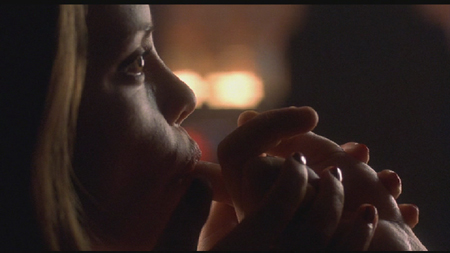
Now it’s Jonathan Rhys-Meyers whose finger is the luckiest man alive.
The Flick
Christina
Ricci plays Elizabeth Wurtzel, a Harvard-bound girl with a journalism
scholarship. Her parents divorced before she was two years old, and she grew up
with her mother. Her father, she says, was never involved enough in her life;
her mother, too much. At Harvard,
expected to do and indulges in excess, ecstasy, and sex. She spins through the
orbits of other students who become, briefly, her friends or lovers before she goes
coasting off in some other direction.
The
character has no vector, no aim, and the film is structured to suit. Apart from
preserving a few tenuous strands of relationships, there’s really no reason
that this disc’s chapters couldn’t be shuffled up and dealt out in any order.
The story would make just about as much sense. Each section involves
cursing out her friends and family for not being able to help her, and then
settling into her depression with feigned comfort. There are no transitions
between sequences, and plot points that start out seeming important are
discarded without even lip-service. There’s no arc and, as I’ll deal with
later, there is consequently no resolution.
Many of
the individual scenes are saved by Ricci’s more-than-adequate acting. She’s fun
as the saucy bitch, she’s demure as the successful writer, she’s downright
frightening as the screaming hellion. She gets the widest array of emotion, and
it’s refreshing and occasionally startling every time she slips out of the
dour, dull mood of

Harvard kids are more clever than you.
The other
actor given anything resembling a range of emotion is Jessica Lange as
spurned figure, a divorcee desperate not to understand her daughter but to fix her. The scenes of tension snapping
between mother and daughter are easily the best in the film.
It’s hard
to get much out of the remainder of the running time, though. There is an
undeniable pretension in both the screenplay and the direction, a design to
make the film a commentary on the human condition. The problem that the crew
ran into is that this is a story about depression, and, as such, is as selfish
and inwardly focused as that disease. This is not a commentary on the human
condition, on our pill-happy nation, on psychiatric medicine; this is a girl’s
diary blown open and filmed.
Prozac Nation sat on the shelf for quite some
time before Miramax released this DVD. During that time, the emo subculture
progressed to a more dominant position, and LiveJournals really took off. This
American audience, at least, is now familiar with the archetype of the weepy
depressive investing their words with more meaning than could possibly be
divested by a reader. It’s arguably tragic that this has become such a cliché,
the argument being that at least four or five of these kids must actually be in
some pain, but it’s undeniably a familiar personality.
profound nor unique. Countless college students abandon their childhoods during
freshman year, taking on new personas along with their various recreational
chemicals. If it weren’t for the selfish tone of the film, the natural
introspection of depression, I would say that
is as real as I am. A cipher shouldn’t write an autobiography.
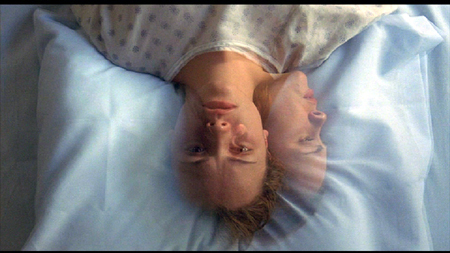
Thanks to Mr. Spock’s valiant efforts, Evil Christina was reunited with Meek Christina.
Skjoldbjærg
made a lot of distracting directorial choices to distract from his films lack
of content. There are obtrusive homages to French New Wave, excessive jump
cuts, time-lapse, intentionally bad focus. All are done in the name of
supporting the tone of an individual scene, but they are highly noticeable,
rather than supporting invisibly. The editing is similarly choppy, but there is
one fine sequence that cuts between news footage of the Challenger shuttle
exploding after takeoff and Lange’s character being mugged and beaten that is
memorable and skillful.
The last
scene is no exception from the mix-and-match suggestion I made above; a
Hemingway quote is tossed out in place of a satisfying resolution, and we’re
left with a character who we are meant to find inspiring simply because she
went on to write the book the film was based on. It’s loose, disconnected, and
maddening because it’s obviously trying to be so much more.
In the
end, though, literary references do not literature make. Prozac Nation is a
showcase for Ricci’s skill, and not much more.
4.0 out of 10
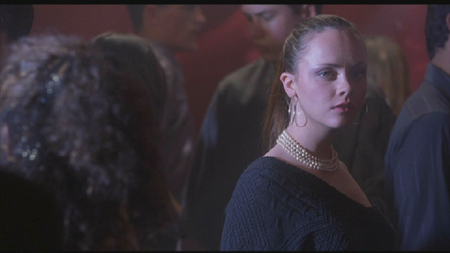
Ms. Ricci receives a premonition, a vision of a future film.
Lightning, excessive hair…
The Look
Widescreen
1.85:1 transfer, which I have no complaints with. Cinematographer Erling
Thurmann-Andersen paints a dull world, full of grays and blacks. Even flesh
(which we get a lot of, though a fair portion is that of Jason Biggs) takes on
a pallid, dead feel everywhere except in the parties and bars.
The use
of color increases toward the end, and
tricks and editing, this is not done at all subtly. The bathroom in which
suicide is done in a warm, lively tone, the color of blood in flesh.
I was so
proud of myself for figuring out the subtext.
6.0 out of 10
The Noise
Dolby
Digital 5.1. The score is moody and pleasant, repeating several motifs so that
they become familiar, rather than using and discarding like so many composers
do these days. (I miss themes. May I have some themes?) Lou Reed, Bruce
Springsteen, the Pretenders, and more fill up the soundtrack to
The
voices, on the other hand, have got some major problems. There is a giant
difference between where the dialogue is in the mix and the volume which
Ricci’s frequent voiceovers inhabit. Often, I had to crank up the volume to
make out a hushed conversation between Elizabeth and her mother, which would
then be interrupted by
on her life.
4.4 out of 10
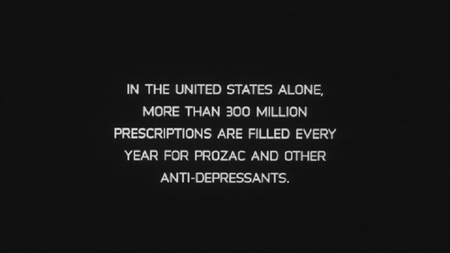
None of them are ever seen again.
The Goodies
An
"Anatomy of a Scene" featurette from the Sundance Channel, which is
of exactly the quality and balance of marketing-hype-to-actual-information that
you might expect, had you seen many of these. (For those who never have, the
ratio is about 15:1.)
1.0 out of 10
The Artwork
If you’re
after the naked Christina Ricci advertised on the cover, you’ve only got to
wait through the opening credits and about half-a-minute of the feature.
The
paraphernalia of a life of substance abuse lay scattered around the bottom,
badly photoshopped, shadows going in different directions. These items are
clutter; they look like an afterthought, and a bad one.
5.0 out of 10
Overall 4.8 out of 10